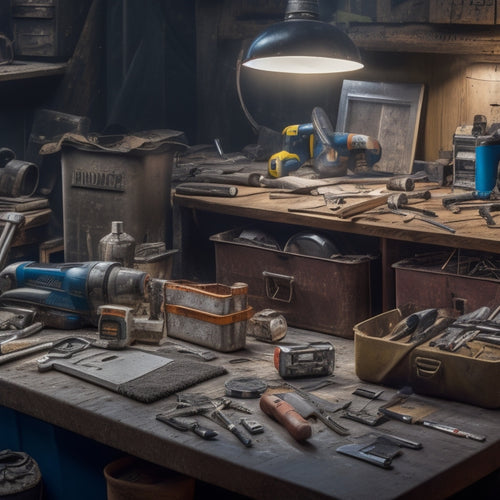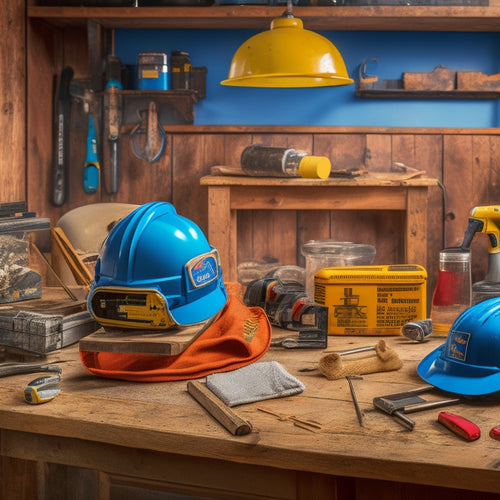
Top DIY Block Splitting Tools for Home Renovation
Share
When it comes to DIY block splitting for your home renovation, you'll need the right tools for the job. Electric block splitting saws are ideal for large-scale projects, offering efficiency and time-saving benefits, but require protective gear and regular maintenance. Handheld block splitting tools provide precise control for smaller projects, while pneumatic block splitting devices utilize compressed air for heavy-duty applications. Hydraulic block splitting machines are robust and efficient, but consider portability, cycle time, and splitting force capacity when selecting the right one. From manual block splitting wedges to block splitting chisel sets, understanding the features and benefits of each tool will help you make an informed decision, and now that you've got a solid starting point, you can take your project to the next level.
Key Takeaways
• Electric block splitting saws are efficient for large-scale masonry projects, but require protective gear and regular maintenance.
• Handheld block splitting tools offer precise control and flexibility for smaller-scale projects, prioritizing safety features and ergonomics.
• Pneumatic block splitting devices utilize compressed air for power and efficiency, but demand safety precautions and regular maintenance.
• Hydraulic block splitting machines vary in splitting force capacity, portability, and cycle time efficiency, making it crucial to select the right machine for specific block types.
• Manual block splitting wedges and block splitting chisel sets are essential for precise control and versatility, requiring careful selection and effective techniques for success.
Electric Block Splitting Saws
When tackling large-scale masonry projects, you'll likely find that electric block splitting saws are the most efficient and cost-effective option for processing large quantities of block material. These powerful tools can greatly reduce the time and effort required to split blocks, allowing you to focus on other aspects of your project.
However, it's crucial to prioritize electric saw safety to avoid accidents and injuries. Always wear protective gear, including safety glasses, gloves, and a dust mask, when operating an electric block splitting saw.
Additionally, make sure the saw is properly maintained by regularly checking and replacing worn or damaged blades, as well as lubricating moving parts. You should also follow the manufacturer's guidelines for maintenance and troubleshooting.
Handheld Block Splitting Tools
By opting for handheld block splitting tools, you can achieve precise control over the splitting process, making them ideal for smaller-scale projects or when working in tight spaces.
These tools are designed to provide you with the flexibility to maneuver around obstacles and accurately split blocks with ease. When selecting a handheld block splitting tool, prioritize handheld safety features such as non-slip grips, ergonomic handles, and protective guards to minimize the risk of accidents.
User ergonomics play an essential role in handheld block splitting tools. Look for tools with contoured handles that fit comfortably in your hand, reducing fatigue and improving control.
Additionally, consider tools with adjustable handles that can be tailored to your grip size and style. This guarantees that you can work efficiently and accurately, even in confined spaces.
With handheld block splitting tools, you can tackle smaller projects with precision and confidence, making them an indispensable addition to your DIY toolkit.
Pneumatic Block Splitting Devices
Pneumatic block splitting devices, which utilize compressed air to drive the splitting process, offer unparalleled power and efficiency, allowing you to tackle larger-scale projects with ease. These devices are ideal for heavy-duty applications, such as splitting thick concrete blocks or large stone slabs.
When operating a pneumatic block splitting device, it's vital to follow proper safety precautions to avoid accidents. Always wear protective gear, including safety glasses, gloves, and ear protection. Confirm the work area is clear of debris and obstacles, and maintain a safe distance from bystanders.
Regular pneumatic tool maintenance is essential to guarantee peak performance and extend the tool's lifespan. Check the air compressor's oil levels, clean the air filter, and inspect the hoses for signs of wear. Additionally, perform routine checks on the device's piston and valve assembly to prevent corrosion and damage.
Hydraulic Block Splitting Machines
When you're considering hydraulic block splitting machines, you'll want to evaluate their splitting force capacity to determine if they can handle the specific blocks you're working with.
You'll also need to think about machine portability options, as this will impact how easily you can transport the machine to different work sites.
Additionally, you'll want to assess the cycle time efficiency of the machine to guarantee it can keep up with your production demands.
Splitting Force Capacity
Your hydraulic block splitting machine's splitting force capacity determines the maximum pressure it can exert to split a block, directly impacting the size and type of blocks you can process efficiently. This capacity measurement is essential in selecting the right machine for your DIY project. A higher splitting force capacity allows you to process larger and harder blocks, while a lower capacity limits you to smaller and softer blocks.
When evaluating a hydraulic block splitting machine, consider the following factors that affect its splitting force capacity:
-
Piston size and stroke: A larger piston with a longer stroke generates more force to split blocks efficiently.
-
Oil pressure and flow rate: Higher oil pressure and flow rate enable the machine to exert greater force to split blocks.
-
Machine design and construction: A well-designed and robust machine can withstand higher pressures and forces, resulting in increased splitting capacity.
Machine Portability Options
As you've determined the required splitting force capacity for your DIY project, you'll want to evaluate the machine's portability options to confirm it can be easily transported to and positioned at the work site. Hydraulic block splitting machines vary regarding tool weight and handling ease, which can greatly impact your workflow.
| Machine Type | Portability Features |
|---|---|
| Compact Splitter | Lightweight (less than 50 lbs), compact design for easy transport |
| Mid-Range Splitter | Balanced weight distribution, ergonomic handles for reduced fatigue |
| Heavy-Duty Splitter | Wheeled base for easy repositioning, lift-assist handles for reduced strain |
| Electric Splitter | Cordless design, reduced weight for improved handling ease |
| Manual Splitter | Ultra-lightweight, ergonomic grip for reduced fatigue |
When selecting a machine, consider the distance you'll need to transport it, as well as the terrain and obstacles you'll encounter. A machine with excellent portability features will save you time and energy, allowing you to focus on completing your DIY project efficiently. By evaluating these factors, you can verify your chosen machine can be easily maneuvered to and around the work site, maximizing your productivity and results.
Cycle Time Efficiency
You'll want to examine the cycle time efficiency of your hydraulic block splitting machine, which is the time it takes to complete a single splitting operation, to verify it can keep up with your project's demands. Cycle time efficiency is critical in hydraulic block splitting machines, as it directly impacts your productivity and overall project timeline.
To optimize cycle time efficiency, consider the following key factors:
-
Machine capacity: Verify your machine can handle the size and type of blocks you're working with to prevent downtime and increase productivity.
-
Piston speed and pressure: Faster piston speeds and higher pressures can considerably reduce cycle times, but be mindful of machine wear and tear.
-
Automated features: Look for machines with automated features, such as automatic block alignment and splitting, to minimize manual intervention and maximize cycle time optimization.
Manual Block Splitting Wedges
When working with manual block splitting wedges, you'll need to select the right wedges for your project and master effective splitting techniques to achieve precise control and efficient results.
You'll want to take into account factors like wedge material, size, and angle to guarantee you're using the best tool for the job.
Wedge Selection Criteria
Selecting the right manual block splitting wedge for your DIY project depends on several key factors, including the type of stone, its hardness, and the desired split pattern. You'll want to evaluate the wedge's material, size, and design to guarantee it can effectively split your stone without damaging it.
When choosing a wedge, take into account the following key factors:
Wedge materials: Steel, iron, and tungsten carbide are common materials used for manual block splitting wedges. Each has its own strengths and weaknesses, so choose one that suits your project's specific needs.
Wedge sizes: Wedges come in various sizes, ranging from small to large, to accommodate different stone sizes and types. Select a wedge that's appropriate for the size and type of stone you're working with.
Wedge design: The design of the wedge can affect its performance. Look for wedges with a tapered or curved design, which can help to concentrate the force and improve splitting efficiency.
Effective Splitting Techniques
With your manual block splitting wedge chosen, it's vital to master effective splitting techniques to achieve precise control over the splitting process and minimize damage to the stone.
Start by ensuring you're wearing important safety precautions, such as gloves, safety glasses, and a dust mask.
Next, carefully examine the material you're working with, taking note of its natural cleavage planes and potential weaknesses.
Position the wedge along these planes, applying gentle yet firm pressure to avoid applying excessive stress that could cause the stone to shatter.
As you strike the wedge, maintain a consistent, controlled motion, gradually increasing the force as needed.
It's important to listen to the stone, adjusting your technique according to its response.
By doing so, you'll be able to split the block efficiently and accurately, while also minimizing waste and preserving the material's integrity.
Block Splitting Chisel Sets
You'll need a reliable block splitting chisel set to efficiently split blocks along their natural grain lines. A good set should include a variety of chisels with different widths and angles to tackle various block splitting materials. When choosing a chisel set, look for high-quality, durable construction that can withstand the rigors of repeated use.
Here are some essential features to evaluate:
-
Chisel material: Look for chisels made from high-carbon steel or tungsten carbide for maximum durability and resistance to wear.
-
Handle design: A comfortable, ergonomic handle design can reduce fatigue and improve control during extended use.
-
Storage and organization: A well-organized storage case can help keep your chisels protected and within easy reach, making it easier to maintain and store them.
Remember to follow chisel maintenance tips to extend the life of your tools. Regularly clean and dry your chisels to prevent rust, and apply a light coating of oil to protect the metal.
Frequently Asked Questions
Can I Use Block Splitting Tools on Frozen or Wet Blocks?
When working with blocks, you'll encounter situations where they're frozen or wet.
Can you use block splitting tools in these conditions? Generally, it's not recommended to split frozen blocks, as they're more prone to shattering, making the process unsafe and unpredictable.
In wet conditions, you'll face reduced splitting efficiency and increased tool wear. However, some specialized tools are designed to handle wet blocks.
Always check the manufacturer's guidelines before proceeding, and consider drying the blocks or using a tool specifically designed for wet conditions to guarantee the best results.
How Do I Properly Store Block Splitting Tools When Not in Use?
When you're not using your block splitting tools, proper storage is essential to maintain their performance and longevity.
You'll want to invest in tool organization systems, such as toolboxes or storage bins, to keep your tools dry, clean, and protected from damage.
Consider storage solutions with individual compartments or dividers to prevent tools from scratching or tangling.
Are Block Splitting Tools Suitable for Splitting Concrete Pavers?
As you crack open the world of paver splitting, you'll find block splitting tools are a double-edged sword - effective, but with limitations.
When it comes to concrete pavers, these tools can be suitable, but only if you're using the right paver splitting techniques.
Not all block splitting tools are created equal, and concrete block compatibility is key. Verify your tool is designed for concrete, and follow the manufacturer's guidelines to avoid damaging the paver or the tool itself.
Can I Rent Block Splitting Tools for a One-Time Project?
You're likely wondering if renting block splitting tools is a viable option for your one-time project. The answer is yes, you can rent them!
Tool rental benefits include significant cost savings and access to specialized equipment without long-term storage concerns.
Explore block rental options at local hardware stores or equipment rental centers, which often carry a range of tools suitable for concrete paver splitting.
Do Block Splitting Tools Require Regular Maintenance or Servicing?
When you invest in block splitting tools, you'll need to take into account maintenance frequency to guarantee peak performance.
Regular servicing is essential to prevent wear and tear and extend the tool's lifespan. You'll want to check and lubricate moving parts, clean the tool after each use, and store it in a dry place.
Follow these servicing tips to minimize downtime and keep your block splitting tools in top condition.
Conclusion
You've successfully sifted through the spectrum of DIY block splitting tools, from electric saws to manual wedges.
Now, you're poised to precision-pick the perfect device for your home renovation project.
Remember, each tool type tantalizes with its unique traits, so carefully consider your concrete-cracking needs.
With the right tool in hand, you'll be splitting blocks like a pro, effortlessly executing your vision with finesse and flair.
Related Posts
-

Smart Guide to Buying Second-Hand Renovation Tools
When buying second-hand renovation tools, you'll want to set clear renovation goals and a realistic budget to priorit...
-

5 Must-Have Plastering Tools for Safe Renovation
You'll need a range of essential tools to tackle your plastering project safely. Invest in a variety of trowels, incl...
-

Top 3 Safety Essentials for DIY Renovations
When tackling a DIY renovation, you'll want to prioritize three essential safety items to protect yourself from poten...


